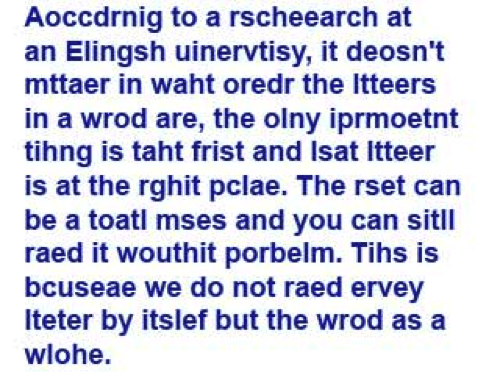Sigmund Freud, once stated, that words and magic were in the beginning the same thing. While there is a certain sense of the fantastic about Freud’s statement, the fact that he is considered to have laid the foundation stones of the pantheon of modern psychology cannot be denied.
Effectively, his words, or magic, cannot be taken lightly. In fact, Freud was right in positing that words and magic are the same. Take for example the concept of garbled text being made sense out of by the human mind. There are countless such texts that have gone viral in the history of internet where the text is garbled in a wide variety of ways.

For instance, vowels have been removed from such text or the positions of letters have been jumbled. The concept is that such text can be read by any individual as if he was reading normally which is true in the majority of cases. In simple terms, individuals have been able to read such text with ease and with little discomfort. A research at the University of California shows the importance of words to the human mind and the kind of impact they can have if the right ones are used in the right situation and in the right order.
For bloggers, online publishers, internet entrepreneurs, and website owners, nothing is more important than understanding what the psychology is like behind writing online and which words matter the most. There have been numerous studies that have been done on the value of words and written text in to humanity over the years. The following is a combined lesson that those researches and studies teach.
What Words Mean And How They Sound
There is a clear difference between the meaning of the words and what they sound like. This is the root cause of misunderstandings in relationships because the same words mean different things and sound differently to different people.

While context provides a window into how we behave, words can steer us towards a particular pattern of behavior through frame manipulation.
One great example here is Tversky and Kahneman’s famous experiment from 1981, which demonstrated reversal of preference when the same statement was presented in a different way.
The task given to participants was to make a decision, and the researchers tried to determine whether they could steer the participants towards another answer just by wording the same question differently.
The experiment proposed a hypothetical outbreak of disease with 60,000 predicted deaths, and participants had to choose between two programs:
- Program A
20,000 people will be saved. - Program B
33% probability that all 60,000 will be saved, and a 66% probability that none of them will be saved.
With these options, program A was a favorite among participants. But what happened when the same question was asked again, but, instead of presenting the number of lives saved, presenting the number of deaths? Here’s how the second option sounded:
- Program A
40,000 people would die. - Program B
There is a 33% probability that none of them would die, and a 66% probability that all of them would die.
Surprisingly, this time, the winner and favorite option was program B.
As you can see, the math behind both the options is same: 40,000 out of 60,000 would die anyway. But with the first option, participants were given the choice of a gain: they were given the choice to save 20,000 people. So, the gamble was perceived as negative against the word “save”.
In the second option, participants were given the choice of a loss.
Participants were influenced simply by the wording. This is exactly the reason why people are much more likely to buy meat when it’s labeled as 85% lean, instead of 15% fat. And it’s why twice as many patients opt for surgery when told they have an 80% chance of surviving, instead of a 20% chance of dying.
This was a fact that was discovered by Dr Sophie Scott of the University College London where she is a speech neurobiology expert.
Dr Scott discovered that every time the human brain hears speech, it separates it to words and melodies and sends them to different processing centres. This means that the human mind clearly distinguishes between the words being used and the tone in which they are being said and uses a combination of this information to make head or tails of what they are hearing.
Effectively, the challenge for an online writer is to understand that he has the disadvantage of not being able to convey meaning through tone and only has to depend on his words. This increases the importance of keeping words simple and common enough for a generic reader to understand the message.
Expressions and Body Language Are Nonentities
The age old wisdom in the field of communications is that the content of a message plays only about a 7 percent role in a message being understood and the other 93 percent can be attributed to body language and tone of voice.

This rule, however, has been debunked off late by many scientists and scholars, one of which is Phillip Yaffe. Phillip says that the 7 percent rule is nothing but a clear misunderstanding of the original research conducted by Professor Albert Mehrabian. According to Mr. Yaffe, nothing is more important in conveying a message than the words used in it.
In order to prove his point, Mr. Yaffe focuses on Abraham Lincoln’s ‘Gettysburg Address’ which is still considered by many to be one of the most perfect examples of the most coherent and effective messages in human history.
The key point specified by Mr. Yaffe was simply that listeners of this message did not have the benefit of expressions, body language, or even tone of words. His suggestion is simply to ensure that your message is clear instead of confusing and organised instead of being unstructured.
An article can be well organised if the following tips are kept in mind.
- The article must follow the inverted pyramid structure of article writing taught to journalists all over the world. The emphasis of this structure is to provide information in descending order of importance so that the end of the article ends up being based on background rather than act as a punch line.
- Similarly, certain online writers like to use deduction and syllogism in their messages a lot. In such a situation, the sequence of facts and arguments must be followed strictly so as to prevent the reader from trying to scroll up and down all the time to make sense of what is being said.
- Breaking down articles into smaller segments with information subheadings can go a long way in organising the whole message in a coherent manner. Smaller segments give a certain grace to the article body while also making it easier for the reader to navigate from one section to another with convenience.
- Depending upon the nature of the article being written, the conclusion must be considered carefully. For instance, sales messages often end with a call to action, which is nothing but a word or a phrase aimed at persuading the reader to take the action that the whole article was trying to build up to. Moreover, the conclusion of an article also depends heavily on the nature of the target audience.
- In simple words, direct consumers prefer a more informal and open form of writing while a professional audience may look for formal and fact based expositions as opposed to opinions. This means that if you are targeting the common man then your article must be simple and should end with a call to action but if your online writing is for B2B purposes then a professional tone may be more relevant.
Sizing Your Arguments Right
If you have had someone teach you how to write for the online audience, then you must have heard that you should always try to keep your paragraphs small and easy to understand. The logic you must have received for this is that the attention span of the online audience is very small and that they are easily distracted.
This is explained in the Andrew Newberg’s book ‘words can change your brain’, where he explains that the human mind can only hold about four concepts at any one time.
Therefore, long-winded paragraphs are inadvisable for an online writer. Another thing online writers need to keep in mind is to avoid using adverbs as much as possible because they tend to increase the word count and make the article more tedious for a reader. This is explained in much more detail by Kim Peres in his article – avoid writing adverbs.

Ambiguous Words Used In Right Combination Become Unambiguous
Sometimes, people use words that mean one thing but are perceived as something else entirely. The best example of this comes from Mary Ellen O’Toole, a Ph.D. in Criminal Minds. As per Ms. O’Toole in her article titled understanding violent criminal behavior, usage of words like ‘monster’ and ‘evil’ to describe offenders who are accused of particularly reprehensible crimes is often misleading. Ms. O’Toole explains that usage of such words with ambiguous meanings can end up having an impact on the readers’ minds.
The same logic applies to writing online because an online writer has to get a very subtle message across to the reader in a very subliminal manner. This cannot be done heavy-handedly. Thus, while less considered use of such words can lead to many ramifications, as an online writer, you only need to worry about one thing and that is whether your intended message is coming across properly or not.
Therefore, if there is a sentence whose meaning could be a little ambiguous then it is much better to restructure it in a way that is more well defined. A typical example of this is the sentence ‘place the box on the table by the window in the bedroom’. This sentence can be interpreted in three different ways.
- Pick up the box from the table, which is standing next to the window and put it in the bedroom.
- Pick up the box from the table and put it next to the window in the bedroom.
- Pick up the box and put it on the table that is standing next to the window in the bedroom.
Using Open and Close Ended sentences To Elicit Thoughtful Reactions
The trick for an online writer is to engage the reader and get him interested enough to gobble the whole content. The best way to engage a reader is to keep interacting with him. Take for example this article – Mistakes That Clients Make in Keyword Selection that keeps using similes and metaphors that are both creative and thought provoking to a point where they keep the reader enmeshed in his imaginations while gently getting the message across.
While it is understandable that online content is passive in nature with no immediate feedback to write-ups, you can still create your content in a manner where the reader remains interested because you are making him think and relate to what your message is.
This means that you will have to use everything in your power from using open and close ended questions, making references, and trying to appeal to their opinions and certainties. This is something that journalists and TV show hosts do very well in their interviews as explained by Shane Snow in his article on the subject.
Utilising Trigger Words for Having a Greater Impact
Research by scientists and experiences of career online writers has revealed that there are certain words that online readers tend to respond better to than others. Some examples of these types of words include you, free, because, new, and instantly.
Each of these five words has its own appeal when it comes to persuading the reader with your content copy. For instance, ‘you’ creates a personal connection with the reader, ‘free’ gives him incentive which keeps him interested, ‘because’ gives an explanation which satisfies a basic human need, ‘new’ caters to his desire for having something exclusive, and ‘instantly’ supports the need for instant gratification. Each of these words is better explained by Gregory Ciotti’s article – the 5 most persuasive words in the English language.
The Right Ratio of Positive Wording and Negative Wording
There is also a relation between the positivity, and negativity, inherent in your message and how the reader reacts to your message. This means that whether your message is positive or negative will have a bearing on how much of an impact your message has on your reader.
For instance, negative messages are more likely to push away the reader as opposed to positive messages if he gets time to consider the messages as is the case with online writing. In contrast, negative messages work best where the receiver does not get enough time to consider his decisions.
As is obvious, these results of a study conducted by the Stanford Graduate School of Business make positive messages more suitable for an online writer. General happiness also works in making the reader more willing to buy things and spend money.
The aforementioned Andrew Newberg suggests that there is a huge difference in the impact of the message because negative messages tend to have an almost involuntary, detrimental reaction in the brain. His suggestion is to write content with a three to one ratio of positive statements to negative statements. While three to one ratio of positive to negative is good, it is ideal to have pieces of content, which only contain negativity if the nature of the message calls for it. Unless there is context for the negative content, it is advisable to avoid it altogether.
In addition to everything mentioned above, understanding the nature of your audience is also important because this understanding will facilitate your efforts to strike a harmonious note with your readers. This is akin to profiling which is done in virtually all walks of life ranging from catching criminals to making sales.
Image Credits: Esche hands, Writing online.
Ankit is a co-founder @ AdPushup (a tool which helps online publishers optimize ad revenues) and loves online marketing & growth hacking.





